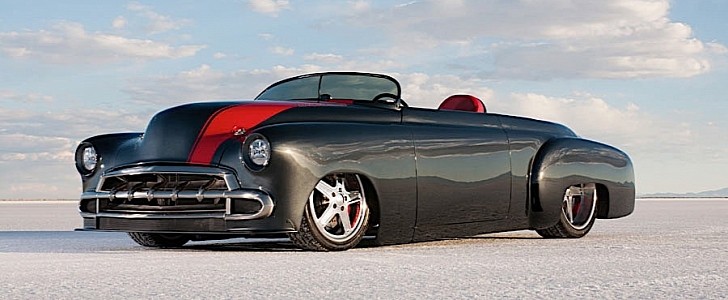If you’re a fan of the American cars of old, then the name Chevrolet Bel Air should ring a lot of bells, and instantly create a lot of images in one’s head. The thing is, probably none of those images look anything like this.
Yes, what you see before your eyes is a Chevrolet Bel Air, one from 1950. Or, should we say, was, as this thing here looks nothing like the car it is based on.
It’s called Boost, and it is the work of a Utah-based garage by the name Weaver Customs, following an idea by Pfaff Designs. It was shown for the first time in 2013 at the Detroit Autorama, where it snatched the Outstanding in Class Radical Custom. Because, as you can see, it is a radical custom.
The car boast body panels that are nothing like the original, put there as a means to make it look more like a racer. Remade in the form of a two-seat roadster, the Boost is shaved as smooth, looking massive and impressive in the Gun Metal Gray paint it comes wrapped in.
As with any custom project of this magnitude, not all the body parts are original to the Bel Air, but have been made to fit perfectly with the build. There is a custom front splitter up front, a speedster-style windshield, and a unique rear end rocking a Flowmaster exhaust at the end of a flipped 1951 Chevrolet grill.
The red interior comes with a completely new dashboard holding Dakota Digital gauges, and a sporty-looking and center console, steel frames holding the two seats, and speakers in the panels behind them.
The car and passengers move along under the power of a supercharged 383ci (6.3-liter) of undisclosed power, controlled by means of a 3-speed automatic transmission.
Like many other custom cars that steal the spotlight, this car’s 15-minutes of fame are long gone. After the first appearance in Detroit, it was sold in 2014 at a Barrett-Jackson auction for $71,500.
Since then, the world has lost track of this build.
It’s called Boost, and it is the work of a Utah-based garage by the name Weaver Customs, following an idea by Pfaff Designs. It was shown for the first time in 2013 at the Detroit Autorama, where it snatched the Outstanding in Class Radical Custom. Because, as you can see, it is a radical custom.
The car boast body panels that are nothing like the original, put there as a means to make it look more like a racer. Remade in the form of a two-seat roadster, the Boost is shaved as smooth, looking massive and impressive in the Gun Metal Gray paint it comes wrapped in.
As with any custom project of this magnitude, not all the body parts are original to the Bel Air, but have been made to fit perfectly with the build. There is a custom front splitter up front, a speedster-style windshield, and a unique rear end rocking a Flowmaster exhaust at the end of a flipped 1951 Chevrolet grill.
The red interior comes with a completely new dashboard holding Dakota Digital gauges, and a sporty-looking and center console, steel frames holding the two seats, and speakers in the panels behind them.
The car and passengers move along under the power of a supercharged 383ci (6.3-liter) of undisclosed power, controlled by means of a 3-speed automatic transmission.
Like many other custom cars that steal the spotlight, this car’s 15-minutes of fame are long gone. After the first appearance in Detroit, it was sold in 2014 at a Barrett-Jackson auction for $71,500.
Since then, the world has lost track of this build.





